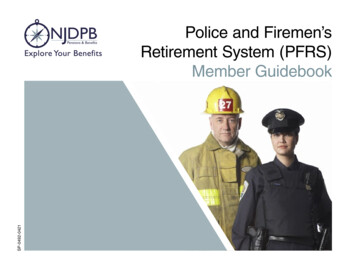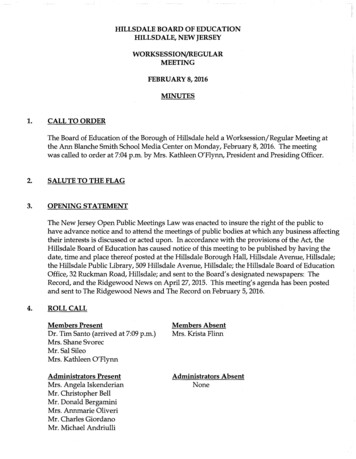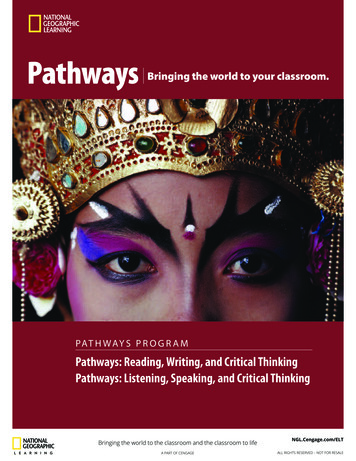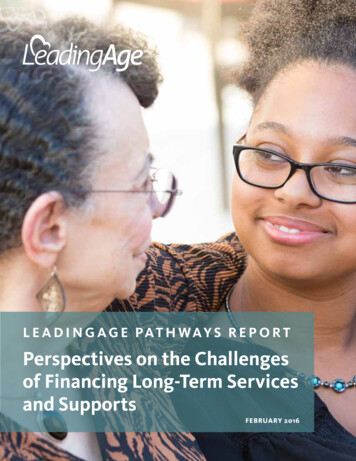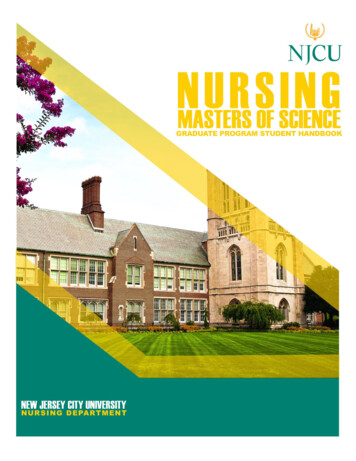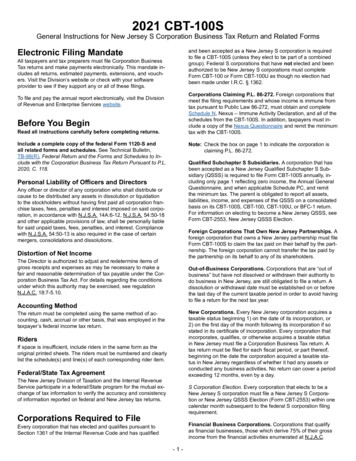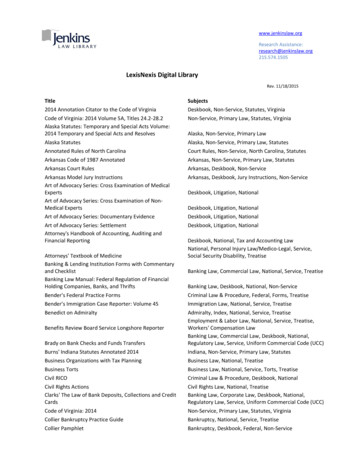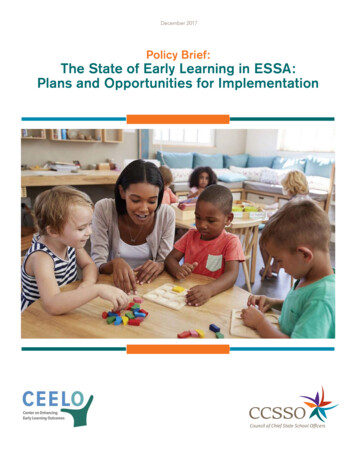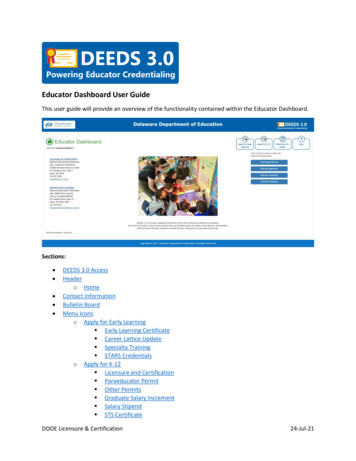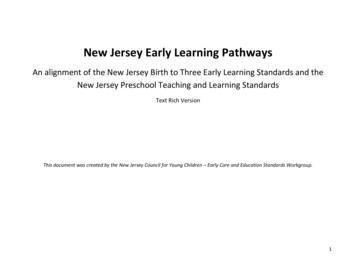
Transcription
New Jersey Early Learning PathwaysAn alignment of the New Jersey Birth to Three Early Learning Standards and theNew Jersey Preschool Teaching and Learning StandardsText Rich VersionThis document was created by the New Jersey Council for Young Children – Early Care and Education Standards Workgroup.1
Table of ContentsAcknowledgements . 4How to use New Jersey's Early Learning Paths . 5How is the New Jersey Early Learning Pathways document organized? . 5Supporting the Developmental Process of Social and Emotional. 10Domain 1: Social and Emotional Development . 11Component: Trust and Emotional Security . 11Component: Self-Awareness . 13Component: Self-Regulation . 19Component: Relationships with peers and adults . 24Approaches to Learning . 32Supporting the Developmental Process of Approaches Learning . 34Domain II: Approaches to Learning . 35Component: Persistence . 35Component: Curiosity . 36Component: Creativity . 37Component: Initiative . 39Pathways of Language Development and Communication Development . 41Supporting the Developmental Process of Listening and Understanding to Language and Communication . 43Domain III: Language Development . 44Component: Listening, Speaking and Understanding . 442
Component: Emergent Literacy. 49Cognitive Development . 51Supporting the Developmental Process of Cognition . 53Domain IV: Cognitive Development . 54Component: Memory . 54Component: Imitation and Symbolic Play . 57Physical and Motor Development . 59Fine Motor Development . 61Physical Health & Well-Being . 64Supporting the Developmental Process of Physical Health and Well – Being. 67Supporting the Developmental Process of Gross Motor . 68Supporting the Developmental Process of Fine Motor Development . 69Domain V: Physical and Motor Development . 70Component: Gross Motor Development . 70Component: Fine Motor Development . 71Component: Physical Health and Well-Being . 723
AcknowledgementsSpecial thanks to the committee members for their dedication:Pamela Brilliante, William Paterson UniversityDenise Burns – Jennings, Mercer County Special ServicesSchool DistrictKathleen Priestly, New Jersey Early Learning TrainingAcademyDebra Rochford, Red Bank Primary SchoolAyanna Crawford, Bergen – Lafayette Montessori SchoolAllison Schneider, Waterfront Montessori SchoolSonja de Groot Kim, Kean UniversityChristine Sevilla, Joseph F. Cappello SchoolAmy Goerl, New Jersey Early Learning Training AcademyMelanie Thiesse, The Westmont Montessori SchoolRoseanne Hanley, New Jersey Department of EducationGambi White – Tennant, New Jersey Council for YoungChildrenKimberley Harrington, New Jersey Department ofEducationKaren Melzer, The Boggs Center, Rutgers UniversityInes LeCerf, New Jersey Department of Children andFamiliesSuzanne Williamson, Monday MorningLaura Morana, New Jersey Department ofEducation/NJCYC - Early Care and Education StandardsWorkgroup ChairpersonSilvana Zircher, East Windsor Regional School DistrictDanielle Yamello, Red Bank Borough Public SchoolsDebbie Schnoll, NJDOE, Graphic Artist4
How to use New Jersey's Early Learning PathsThis is a developmental alignment document. It presents developmental standards for children birth to 60 months or five years old. Thedocument provides developmental milestones that reflect the developmental continuum from birth to preschool in typically developingchildren. Specific and deeper information on the domains and components can be found in the individual standard documents for the agegroup, New Jersey Birth to Three Early Learning Standards or the New Jersey Preschool Teaching and Learning Standards. This is only aguide and should not be used to determine if a child is developmentally delayed or advanced. The following information will guide youthrough this document.How is the New Jersey Early Learning Pathways document organized?Information contained in the New Jersey’s Early Learning Pathways mirrors the wording found in the Birth to Three Early Learning Standardsand the New Jersey Preschool Teaching and Learning Standards. In this way, it will be easy to look into the Birth to Three Early LearningStandards or the Preschool Teaching and Learning document for additional information regarding a particular standard.The content in this document is organized by developmental area for ease of use. Each developmental area or domain consists ofaccompanying component areas. For example:Table 1: Domain and ComponentsDomainSocial and Emotional DevelopmentApproaches to LearningComponents Trust and Emotional SecuritySelf-AwarenessSelf-RegulationRelationships with Peers and Adults PersistenceCuriosityCreativityInitiative5
DomainLanguage Development and Communication ComponentsListening and UnderstandingCommunication and SpeakingEmergent and Emerging LiteracyCognitive Development Exploration and DiscoveryMemoryProblem SolvingImitation and Symbolic PlayPhysical and Motor Development Moves body, arms, and legs with coordinationDemonstrates large muscle balance, stability, control and coordinationDevelops increasing ability to change positions and move body from place to placeMoves body with purpose to achieve goalThe following tables demonstrate the organization of this document. Table 2 shows the Developmental Continuum section of thedocument that precedes each domain. Table 3 shows the developmental range from young infant to preschooler in social and emotionaldevelopment.Note: Please be aware as you use this document, if a child has not been exposed to interactions, activities and/or materials to stimulate andsupport certain developmental areas they may not present at their chronological age.6
Table 2: Developmental Domain: Approaches to LearningComponentCuriosity Persistence Creativity Birth to Three Early Learning StandardsBirth to 36 monthsShows interest in and actively explores theenvironment.Shows eagerness and curiosity as a learner.Seeks to discover and learn new things.Attends to and tries to reproduce interestingevents.Maintains social contact by continuing toengage with caregiver.Attempts challenging tasks with or withoutadult help.Explores thoroughly and tries to solveproblems even when encountering obstacles. Uses unusual ways to explore people or objects in the environment. Finds new things to do with familiar objects.Uses imagination in playful, silly or messy ways. Preschool Teaching and Learning Standards36 months to 60 monthsChildren demonstrate initiative, engagement andpersistence.Children demonstrate self- direction.Children identify and solve problems.Children apply what they have learned to a newsituation.Children identify and solve problems.Children apply what they have learned to newsituations.Children demonstrate initiative, engagement andpersistence.Children demonstrate self-direction.Children exhibit positive interactions with otherchildren and adults.Children show creativity and imagination.Children express themselves through and developan appreciation of movement and dance.Children express themselves through and developan appreciation of dramatic play and storytelling.Children exhibit pro-social behavior.Begins to use electronic devices to communicate.7
ComponentInitiative Birth to Three Early Learning StandardsBirth to 36 monthsVocalizes or make noise to attract caregiver’sattention.Lifts arms up in order to be picked up bycaregiver.Approaches other toddlers and watches orstarts to play close by.Says “hello” to a new child on the playground. Preschool Teaching and Learning Standards36 months to 60 monthsChildren apply what they have learned to newsituations.Children demonstrate self-confidence.Children exhibit positive interactions with otherchildren and adults.Children exhibit pro-social behaviors.Children express themselves through and developan appreciation of dramatic play and storytelling.Children demonstrate initiative, engagement andpersistence.Children demonstrate self-direction.8
Social and Emotional DevelopmentTable 3: Social and Emotional Developmental Continuum: Trust and Emotional Security to Social CompetenceSocial and EmotionalDevelopment StagesYoung Infants(Birth to 9 months)Older Infants(8 – 18 months)Young Toddlers(16 – 26 months)Listens intently tofamiliar voices.Cries when left witha new caregiver, butmay respond tosoothing words,holding and otherforms of comfort.Reaches for familiarcaregiver when anunfamiliar adultapproachesStares at own handsor feet as theymove.Smiles at ownreflection in mirroror makes soundswhen looking atimage in the mirror.Can identify eyes,Wants to do thingsnose, mouth orby him/her self.other body parts andcan also point tothem on others.Engage in pretendplay.Self - RegulationStops crying whenheld and gentlyrocked or talked toby familiarcaregiver.Holds on bottle orfeeds self withfingers.Follows simple one- Adjusts to some,step directions, such changes in activitiesas, “Get your shoes.” or routines withoutdistress.Demonstrateunderstanding theconcept of sharing byattempting to share.Relationships withPeers and AdultsQuiets down andsmiles when he/shehears own namespoken by familiarperson.Sits next to andplays with sometoys that otherinfants have.Knows the names ofsome other childrenand some adults.Says “thank you,”“please,” and“excuse me.”Trust and EmotionalSecuritySelf-AwarenessOlder Toddler(24 – 36 months)Preschool(36 – 60 months)Takes turns withDemonstrate sociallycaregiver during play acceptable behaviorand interaction.for teachers andpeers (e.g., give hugs,get a tissue, sit nextto a friend/teacher,hold hands)Imitates tasks, suchas wiping the table,when he/she seesothers doing theactivity.9
Supporting the Developmental Process of Social and EmotionalSupporting young infants in Social and Emotional Development, caregivers can Respond to baby’s messages and cues to determine baby’s needs and continue to try other responses until baby is calmed orsoothed.Hold baby during feeding times and talk to baby in soothing reassuring tones.Supporting older infants in Social and Emotional Development, caregivers can Acknowledge baby’s feelings of anxiety and allow baby to use primary caregiver for security in the presence of unfamiliar adults.Develop familiar routines or rituals for leaving baby with others and find ways to say “good-bye.”Supporting young toddlers in Social and Emotional Development, caregivers can . Have photos of familiar adults and caregivers available when toddler is feeling stressed or upset and talk with him/her about thepeople in the photos.Talk with toddler about where you are going and when you will return.Supporting older toddlers in Social and Emotional Development, caregivers can . Provide encouragement for toddler to try out a new climber or other activity while you remain close by to offer support.Read stories with toddler that tell about families, friends and what people do and where they go.Effective preschool teachers Pair or group children to foster friendship.Provide toys and plan activities to encourage cooperative play.Collaborate with children on activities while modeling language and pretend skills as needed for play.Identify strategies to enter into play with another child or group of children.10
Domain 1: Social and Emotional DevelopmentComponent: Trust and Emotional SecurityDefinition: Feelings of comfort, support and stability from others.Component: Trust andEmotional SecurityBirth to Three EarlyLearning StandardsEngages in behaviorsthat build relationshipswith familiar adults.Component: Trust and Emotional SecurityPreschool Teaching and Learning Standards Social/Emotional Development Standards0.1.3 Actively engage in activities and interactions with teachers and peers. Approaches to Learning Standards9.1.5 Bring a teacher-directed or self-initiated task, activity or project to completion (e.g., showing theteacher, “Look-I finished it all by myself!). Social Studies, Family and Life Skills Standards6.2.3 Demonstrate appropriate behavior when collaborating with others. World Languages Standards7.1.1 Acknowledge that a language other than their own is being spoken or used (e.g., in a story, rhyme, orsong).7.1.2 Say simple greetings, words, and phrases in a language other than their own.7.1.4 Communicate effectively with adults and/or classmates who speak other languages by using gestures,pointing, or facial expressions to augment oral language.11
Component: Trust andEmotional SecurityBirth to Three EarlyLearning StandardsShows preference forfamiliar adults.Component: Trust and Emotional SecurityPreschool Teaching and Learning Standards Seeks ways to findcomfort in newsituations.Shows emotionalconnection andattachment to others. Approaches to Learning Standard9.1.5 Bring a teacher-directed or self-initiated task, activity or project to completion (e.g. showing theteacher, “Look- I finished it all by myself!).Social Studies, Family and Life Skills Standard6.1.1 Describe characteristics of oneself, one’s family, and others.6.1.2 Demonstrate an understanding of family roles and traditions.Visual and Performing Arts Standards.1.1.8 Begin to demonstrate appropriate audience skills during the creative movement and danceperformances.1.2.8 Begin to demonstrate appropriate audience skills during recordings and music performances.1.3.8 Begin to demonstrate appropriate audience skills during storytelling and performances.Social/Emotional Development Standards0.3.3 Channel impulses and negative feelings, such as anger (e.g., taking three deep breaths, using calmingwords, pulling self out of play to go to “safe spot” to relax, expressive activities).Social/Emotional Development Standards0.3.2 Empathize with feelings of others (e.g., get a blanket for a friend and comfort him/her when he/shefeels sad).12
Component: Self-AwarenessDefinition: Individual’s perception of selfComponent: SelfAwarenessBirth to Three EarlyLearning StandardsExpresses feelings andemotions throughfacial expressions,sounds, gestures orwords.Component: Self-Awareness Preschool Teaching and Learning Standards Social/Emotional Development Standards0.3.1 Recognize and describe a wide range of feelings, including sadness, anger, fear, and happiness.0.4.5 Express needs verbally or nonverbally to teacher and peers without being aggressive (e.g., “I don’t likeit when you call me dummy. Stop!”).Visual/Performing Arts Standards1.1.1 Move body in a variety of ways, with and without music.1.1.2 Respond to changes in tempo and a variety of musical rhythms through body movement.1.1.6 Use movement/dance to convey meaning around theme or to show feelings.1.1.7 Describe feelings and reactions in response to a creative movement/dance performance.1.2.1 Sing a variety of songs with expression, independently and with others.1.2.4 Listen to, imitate, or improvise sounds, patterns, or songs.1.2.5 Participate in and listen to music from a variety of cultures and times.1.2.7 Describe feelings and reactions in response to diverse musical genres and styles.1.3.1 Play roles observed through life experiences (e.g. mom/dad, baby, firefighter, police officer, doctor,mechanic).1.3.2 Use memory, imagination, creativity, and language to make up new roles and act them out.1.3.3 Participate with others in dramatic play, negotiating roles and setting up scenarios using costumes andprops1.3.7 Describe feelings and reactions and make increasingly informed responses to stories and dramaticperformances.1.4.3 Use vocabulary to describe various art forms, artists, and elements in the visual arts.1.4.4 Demonstrate a growing ability to represent experiences, thoughts, and ideas through a variety of ageappropriate materials and visual art media using memory, observation and imagination.13
Component: SelfAwarenessBirth to Three EarlyLearning StandardsComponent: Self-Awareness Preschool Teaching and Learning Standards Begins to developawareness of self asseparate from others.1.4.7 Describe feelings and reactions and make increasingly thoughtful observations in response to a varietyof culturally diverse works of arts and objects in the everyday world. Approaches to Learning Standards9.2.3 Use multiple means of communication to creatively express thoughts, ideas and feelings.9.4.3 Demonstrate understanding of what others think and feel through words or actions. Social Studies, Family and Life Skills Standards6.1.1 Describe characteristics of one’s self, one’s family and others.6.1.3 Express individuality and cultural diversity (e.g. through dramatic play).6.3.2 Identify, discuss and role-play the duties of a range of community workers. World Language Standards7.1.4 Communicate effectively with adults and/or classmates who speak other languages by using gestures,pointing, or facial expressions to augment oral language. Visual and Performing Arts Standards1.1.4 Define and maintain personal space, concentration, and focus during creative movement/danceperformances.1.1.5 Participate in or observe a variety of dance and movement activities accompanied by music and/orprops from different cultures and genres.1.2.1 Sing a variety of songs with expression, independently and with others.1.2.5 Participate in and listen to music from a variety of cultures and times.1.3.1 Play roles observed through life experiences (e.g. mom/dad, baby, firefighter, police officer, doctor,mechanic).1.3.2 Use memory, imagination, creativity, and language to make up new roles and act them out.1.3.3 Participate with others in dramatic play, negotiating roles and setting up scenarios using costumes andprops1.3.4 Differentiate between fantasy/pretend play and real events.14
Component: SelfAwarenessBirth to Three EarlyLearning StandardsComponent: Self-Awareness Preschool Teaching and Learning Standards 1.3.6 Participate in and listen to stories and dramatic performances from a variety of cultures and times.1.4.4 Demonstrate a growing ability to represent experiences, thoughts, and ideas through a variety of ageappropriate materials and visual arts media.1.4.5 Demonstrate planning, persistence, and problem-solving skills while working independently, or withothers, during the creative process.1.4.7 Describe feelings and reactions and make increasingly thoughtful observations in response to a varietyof culturally diverse works of art and objects in the everyday world. Approaches to Learning Standards9.1.1 Make plans and decisions to actively engage in learning (e.g., two children greet each other as theyarrive to school and decide that they will finish counting all the bottle caps they collected during the choicetime).9.1.4 Show persistence when faced with challenging tasks and uncertainty, seeking and accepting help whenappropriate (e.g. saying to a friend “this is hard. Can you help me figure it out?).9.1.5 Bring a teacher-directed or self-initiated task, activity or project to completion (e.g. showing theteacher, “Look- I finished it all by myself!).9.3.1 Recognize a problem and describe or demonstrate ways to solve it alone or with others.9.4.3 Demonstrate understanding of what others think and feel through words or actions. Social Studies, Family and Life Skills Standards6.1.1 Describe characteristics of one’s self, one’s family and others.6.1.2 Demonstrate an understanding of family roles and traditions.6.1.3 Express individuality and cultural diversity (e.g. through dramatic play).6.2.3 Demonstrate appropriate behavior when collaborating with others.6.3.2 Identify, discuss and role-play the duties of a range of community workers.6.4.1 Learn about and respect other cultures within the classroom and community. 15
Component: SelfAwarenessBirth to Three EarlyLearning StandardsComponent: Self-Awareness Preschool Teaching and Learning StandardsWorld Language Standards7.1.1 Acknowledge that a language other than their own is being spoken or used (e.g., in a story, rhyme, orsong).Shows confidence inincreasing abilities. Visual and Performing Arts Standards1.1.1 Move the body in a variety of ways, with and without music.1.1.2 Respond to changes in tempo and a variety of musical rhythms through body movement.1.1.5 Participate in or observe a variety of dance and movement activities accompanied by music and/orprops from different cultures and genres.1.1.6 Use movement/dance to convey meaning around theme or to show feelings.1.1.8 Begin to demonstrate appropriate audience skills during the creative movement and danceperformances.1.2.1 Sing a variety of songs with expression, independently and with others.1.2.2 Use a variety of musical instruments to create music and/or with others, using different beats, tempos,dynamics and interpretations.1.2.4 Listen to, imitate, and improvise sounds, patterns, or songs.1.2.6 Recognize and name a variety of music elements using appropriate music vocabulary.1.2.8 Begin to demonstrate appropriate audience skills during recordings and music performances.1.3.2 Use memory, imagination, creativity, and language to make up new roles and act them out.1.3.3 Participate with others in dramatic play, negotiating roles and setting up scenarios using costumes andprops.1.3.5 Sustain and extend play during dramatic performances from a variety of cultures and times.1.3.7 Describe feelings and reactions and make increasingly informed response to stories and dramaticperformances.1.3.8 Begin to demonstrate appropriate audience skills during storytelling and performances.1.4.1 Demonstrate the safe and appropriate use of care of art materials and tools.16
Component: SelfAwarenessBirth to Three EarlyLearning StandardsComponent: Self-Awareness Preschool Teaching and Learning Standards 1.4.2 Create two-and three-dimensional works of art while exploring color, line, shape, form, texture andspace.1.4.3 Use vocabulary to describe various art forms, artists, and elements in the visual arts.1.4.4 Demonstrate a growing ability to represent experiences, thoughts, and ideas through a variety of ageappropriate materials and visual art media using memory, observation and imagination.1.4.5 Demonstrate planning, persistence, and problem-solving skills while working independently, or withothers, during the creative process.1.4.6 Create more recognizable representations as eye-hand coordination and fine-motor skills develop.1.4.7 Describe feelings and reactions and make increasingly thoughtful observations in response to a varietyof culturally diverse works of arts and objects in the everyday world.Approaches to Learning Standards9.1.1 Make plans and decisions to actively engage in learning (e.g., two children greet each other as theyarrive to school and decide that they will finish counting all the bottle caps they collected during the choicetime).9.1.2 Show curiosity and initiative by choosing to explore a variety of activities and experiences with awillingness to try new challenges.9.1.3 Focus attention on tasks and experiences, despite interruptions or distractions.9.1.4 Show persistence when faced with challenging tasks and uncertainty, seeking and accepting help whenappropriate (e.g. saying to a friend “this is hard. Can you help me figure it out?).9.1.5 Bring a teacher-directed or self-initiated task, activity or project to completion (e.g. showing theteacher, “Look- I finished it all by myself!).9.2.1 Show flexibility in approaching tasks by being open to new ideas.9.2.2 Use the imagination to solve problems, use materials, role play, write stories, move the body, or createworks of art.9.2.3 Use multiple means of communication to creatively express thoughts, ideas and feelings.9.3.1 Recognize a problem and describe or demonstrate ways to solve it alone or with others.17
Component: SelfAwarenessBirth to Three EarlyLearning StandardsComponent: Self-Awareness Preschool Teaching and Learning Standards 9.3.2 Use varied strategies to seek or recall information and to find answers.9.3.3 Predict what will happen next based on prior experience and test the prediction for accuracy.9.3.4 Reflect on, evaluate, and communicate what was learned.9.4.1 Use prior knowledge to understand new experiences or a problem, in a new context.9.4.2 Make connections between ideas, concepts, and subjects.9.4.3 Demonstrate understanding of what others think and feel through words or actions. Social Studies, Family and Life Skills Standards6.1.1 Describe characteristics of one’s self, one’s family and others.6.1.2 Demonstrate an understanding of family roles and traditions.6.2.1 Demonstrate understanding of rules by following most classroom routines.6.2.2 Demonstrate responsibility by initiating simple classroom tasks and jobs.6.3.2 Identif
New Jersey Early Learning Pathways An alignment of the New Jersey Birth to Three Early Learning Standards and the New Jersey Preschool Teaching and Learning Standards Text Rich Version . This document was created by the New Jersey Council for Young Children - Early Care and Education Standards Workgroup.
